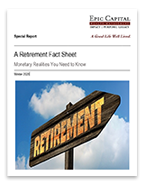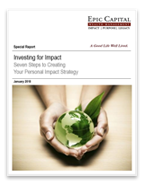Market Update: Volatility Continues
May 18, 2022

2022 has been a challenging year for investors so far. The S&P 500 Index just had one of its worst Aprils in decades, and May is off to a rocky start. Bond investors have not fared much better as rising interest rates have pushed down bond prices. Bond losses have made the stock market volatility feel even worse than usual. Markets don’t like uncertainty but it’s getting a healthy dose of it this year, dealing with high inflation, tighter Federal Reserve monetary policy, COVID-19 shutdowns in China, and snarling global supply chains, all while the war in Ukraine continues.
Investing mistakes often take place during periods of elevated volatility. One of the most frequent is trying to time the market by jumping in and out. Market timers must be right twice, and timing the return to the market can be extremely difficult to pull off. Markets can turn quickly, and missing even just one big up day can significantly reduce returns over time. The biggest daily gains tend to come in down markets, making them especially difficult to predict. Time in the market, not timing the market, may be more beneficial to long term investors.
When markets are shaky, it can be helpful to look to long-term fundamentals that have provided the foundation of positive returns for stocks and bonds over the long run. For stocks, gains depend on the ability of corporations to grow earnings, which they have continued to do during first quarter earnings season—S&P 500 Index earnings per share are on track to increase 10% year over year. For bonds, the key fundamental has simply been the ability of borrowers to make required payments. Corporations and consumers enjoy strong balance sheets and have the financial firepower to pay their debts. While the future is always uncertain, we believe those fundamentals remain in place.
Even against a potentially supportive fundamental backdrop, the volatility we’ve seen in stocks this year is not unusual. Although negative returns for a full calendar year are infrequent, corrections are fairly common. Since 1980, the S&P 500 has been negative for a calendar year just seven times, but the average decline within any year has been 14%. Mid-term election years have tended to see increased early year volatility, as the honeymoon period for a new president ends and political uncertainty rises. Inflation can also be challenging. Years with inflation over 5% have seen more frequent stock market declines than a typical year, but stocks have still been higher more often than not.
Amid the global economic and geopolitical uncertainty, the core domestic economy is still quite stable. Weekly consumer spending data is above typical baseline levels. Job seekers are participating in a tight labor market with twice as many openings as unemployed people. Businesses are enjoying high profit margins despite cost pressures. The economy is expected to grow in the latter part of this year after a surprise contraction in the first quarter, though the growth path may be bumpy as monetary policy is recalibrated from exceedingly loose to moderately tight and consumers and businesses adjust to higher borrowing costs. Our base case is still for above-trend economic growth in 2022.
We believe patient investors stand a better chance of meeting their long-term goals. No one has a crystal ball, but at lower valuations, history suggests the chances of above-average returns going forward may be rising. It’s tough to do during times like this, but we encourage long term investors to stick to their game plan.
Please contact me if you have any questions.
For more insights and resources, be sure to sign up for our Weekly Market Commentary. Follow our YouTube channel where we regularly post our Epic Market Minute videos. Follow us on LinkedIn, or like us on Facebook. And as always, please don’t hesitate to reach out to a dedicated service professional at Epic Capital.
Tags: Current Events, financial advisor, financial advisor charlotte nc, Financial Planner Charlotte NC, Investing, Investment Planning, Personal Finance
More Insights
Did you buy U.S. Savings Bonds decades ago? Or did your parents or grandparents purchase them for you? If they’re collecting dust in a drawer, you may want to take a look at them to see if any of your bonds have matured. If your bonds have matured, that means they are no longer earning … Continue reading “How US Savings Bonds Work”
In baseball, three strikes and you’re out. With inflation, a third straight month of hotter-than-expected consumer inflation data nearly ruled out probabilities for a June rate cut yesterday (now less than a 25% chance, according to fed funds futures). The core Consumer Price Index (CPI) rose 0.4% in March, or 3.8% when compared on a … Continue reading “Market Update – Assessing the Prospect for a Pullback”
You know how important it is to plan for your retirement, but where do you begin? One of your first steps should be to estimate how much income you’ll need to fund your retirement. That’s not as easy as it sounds, because retirement planning is not an exact science. Your specific needs depend on your … Continue reading “Estimating Your Retirement Income Needs”
Let’s talk seasonality. For those that are unfamiliar, seasonality is the tendency for markets to perform better during some calendar periods and worse during others in a somewhat predictable way. One of the more amazing things about 2023 and part of the first quarter of 2024 is how well U.S. equity markets have been following … Continue reading “Can Pre-Election Market Trends Survive This Attention?”
The first quarter is in the books, and it was an excellent one for stocks. The S&P 500 index rode a resilient U.S. economy, easing inflation, rising corporate profits, and anticipation of summertime rate cuts from the Federal Reserve (Fed) to solid gains in March, the fifth straight winning month, and the best first quarter … Continue reading “Market Update – An Excellent First Quarter for Stocks”
Services
Epic Capital provides the following comprehensive financial planning and investment management services: Learn More >


 Top of Page
Top of Page











